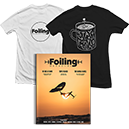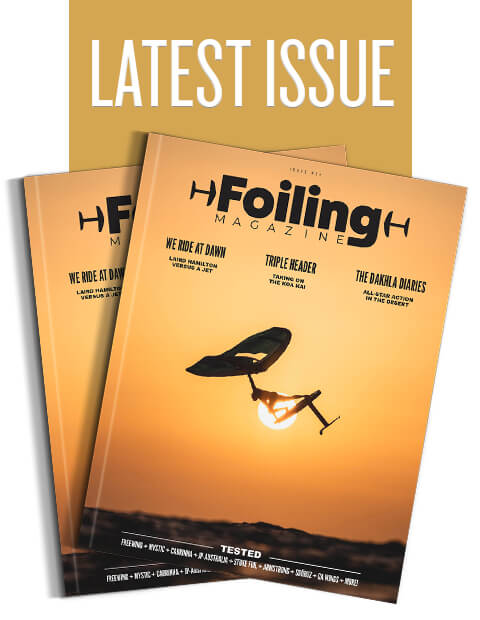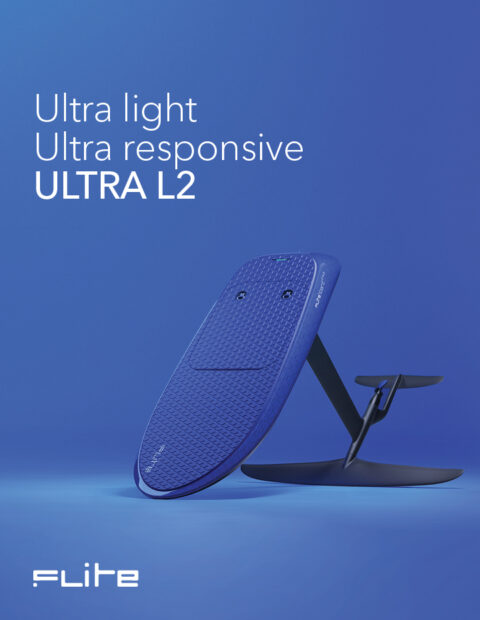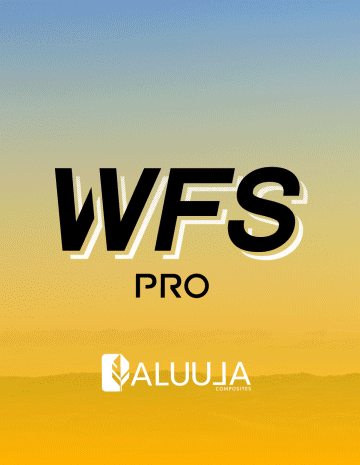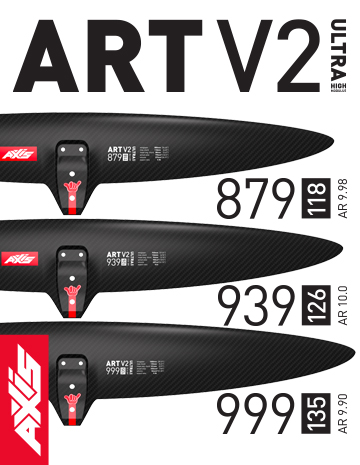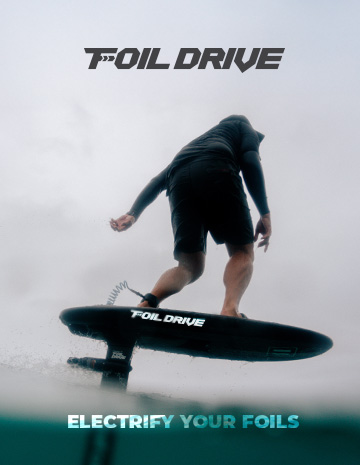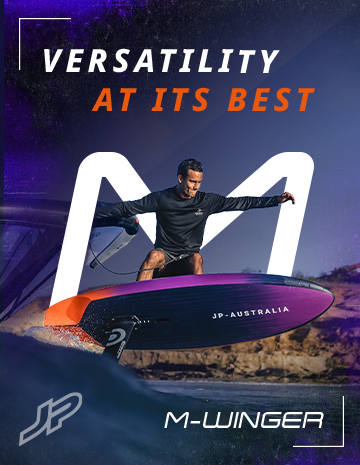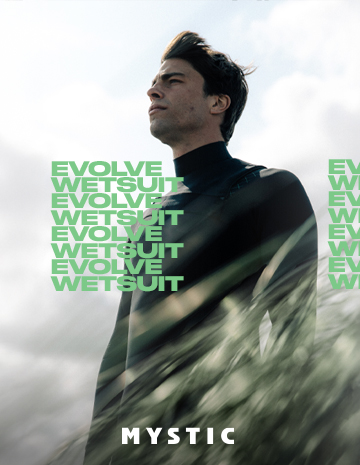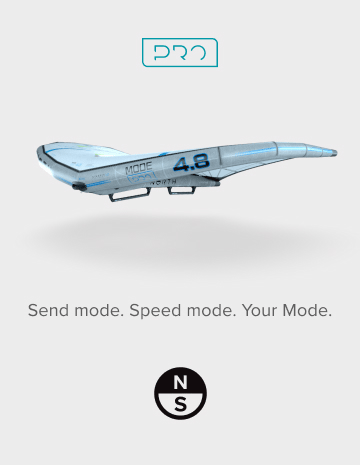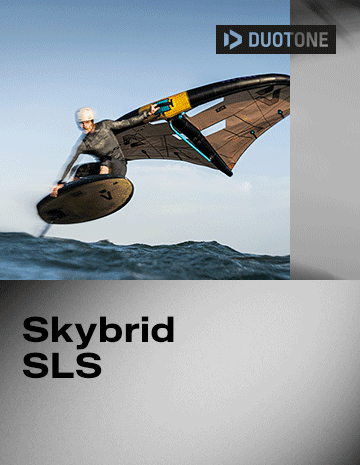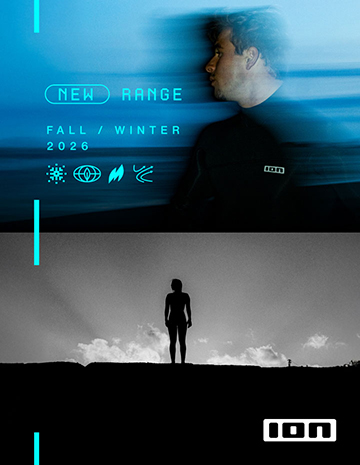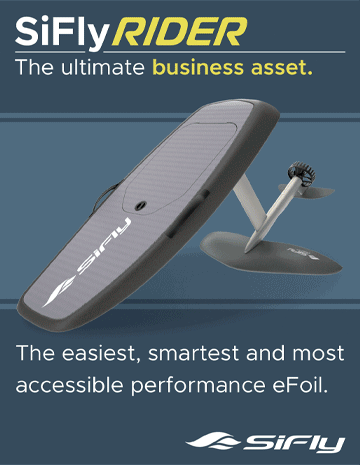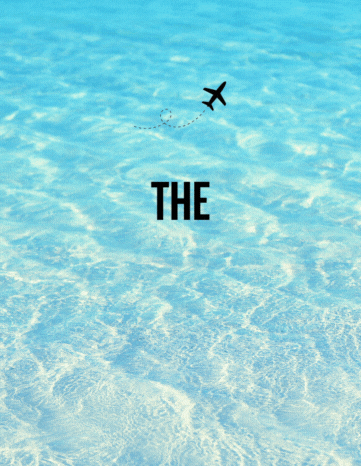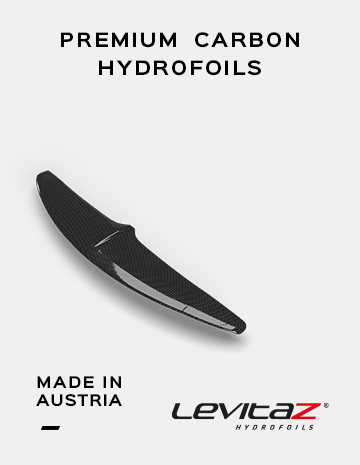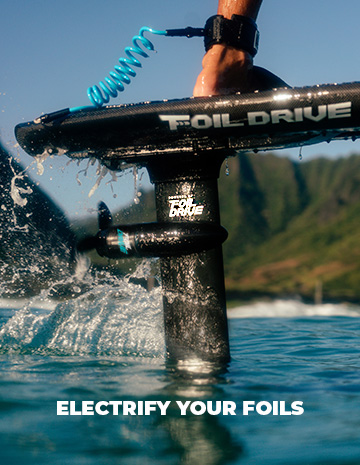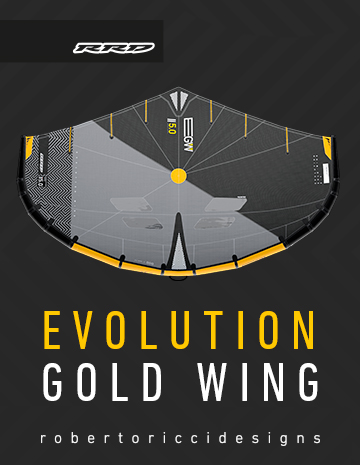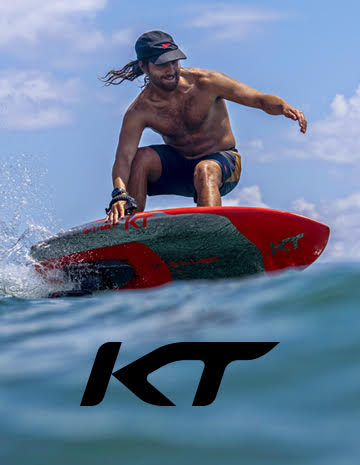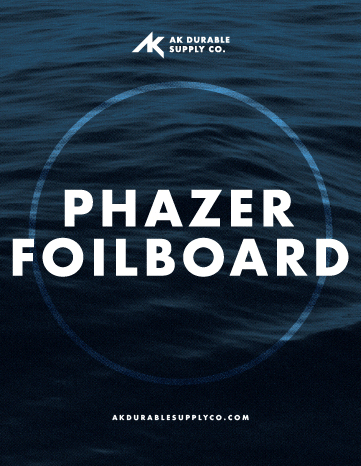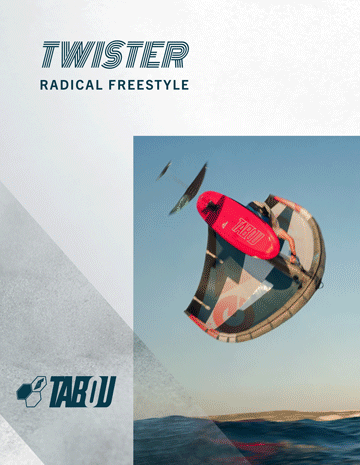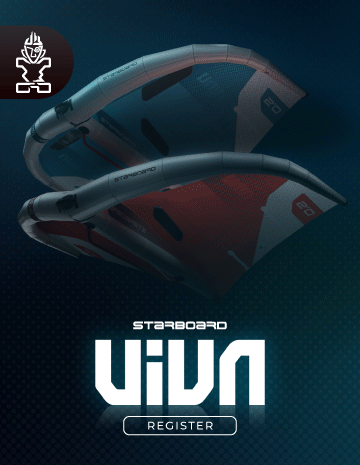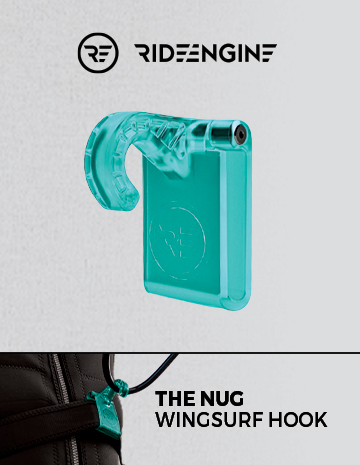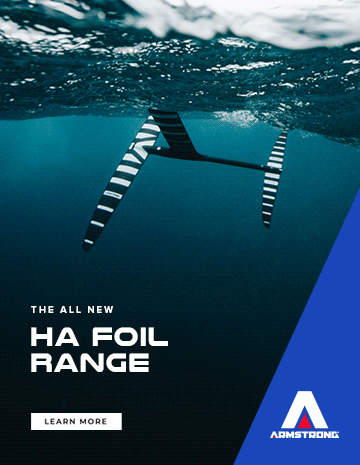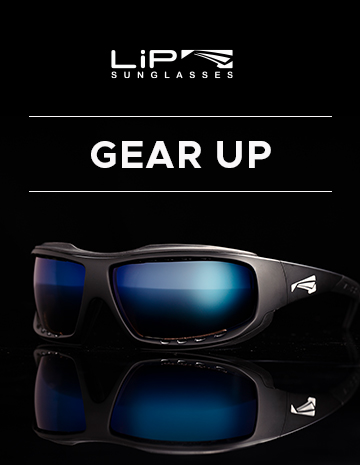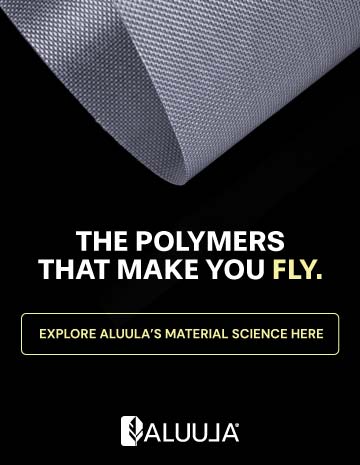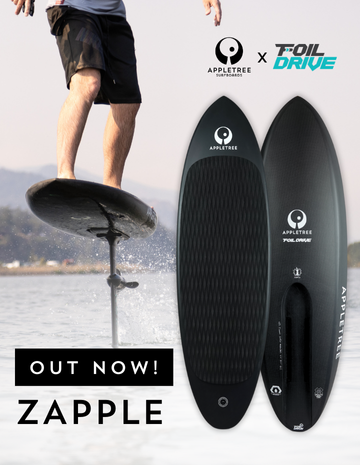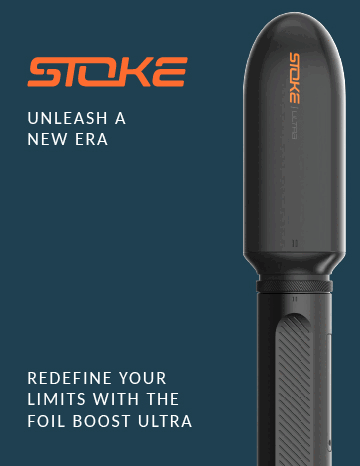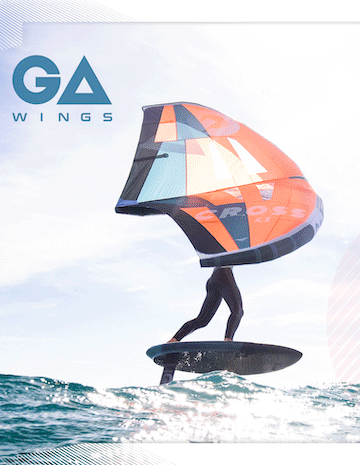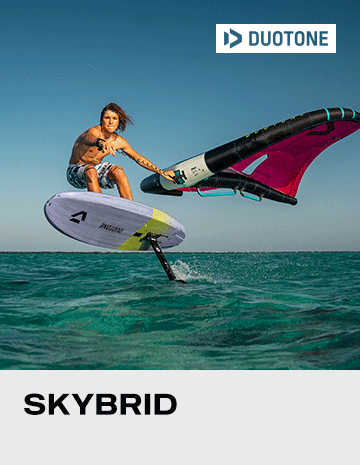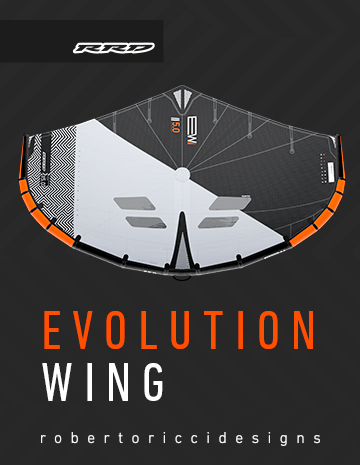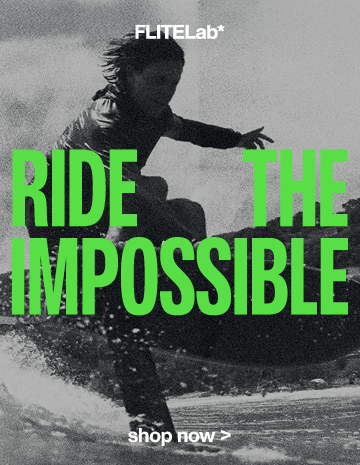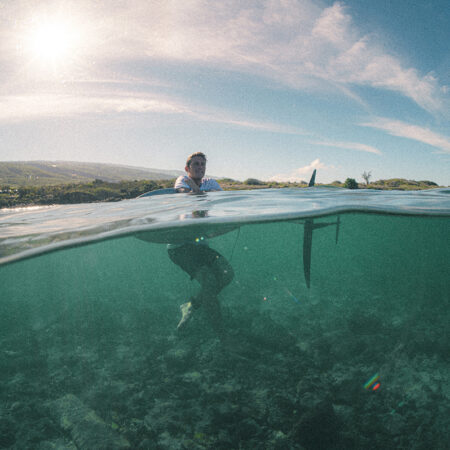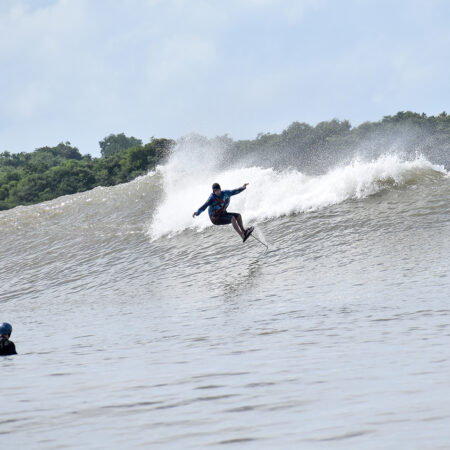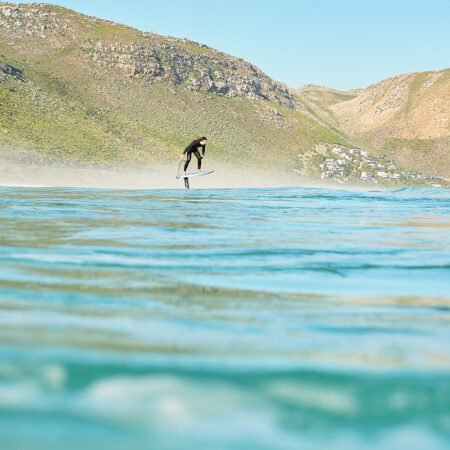All jokes aside, the Ultra is a serious piece of kit, and a work of art at that. For those of you who’ve had the fortune of a hands-on experience with Fliteboard’s products, they are incredibly well designed and finished. Then again, for nearly $12,500, they had better be. In comparison to the Pro (the last Fliteboard I rode), the Ultra is a fair bit smaller. It incorporates system architecture updates leading to a reduction in the number of connecting cables, making setup even easier. With factory-installed footstrap inserts, getting air on this board is more than feasible for experts — it’s designed for exactly that. Although I probably won’t be practicing my e-foil air game anytime soon, it’s inspiring to know what’s possible on the latest generation of these machines. The Ultra’s silver topside and exposed carbon bottom are reminiscent of a Formula 1 car or offshore racing boat, two extreme machines it would look right at home alongside.




 Released in tandem with the Ultra, there are a dozen new wings in the Fliteboard lineup this year. Rudi clues me in on the new Flow, Flow S, and Race wings. Seeing is believing, and in person I can now appreciate the subtle (and not so subtle) details in the shape of these wings; it’s clear they’re designed by a pair of Webb Institute-educated naval architects whose hobbies include going at mind-bending speeds on kite racing foils. With a quiver of the highest-performance foils at home, I can admittedly be a bit of a foil snob. These wings though, I can’t wait to ride. As for the controller, there are also updates to the previous generation. While I know there’s more in the pipeline from Fliteboard on this front, Rudi tells me experienced users are enjoying the subtle changes for the new generation. The entire system links up to the Fliteboard app, giving users all sorts of data about their board, riding, and software info.
Released in tandem with the Ultra, there are a dozen new wings in the Fliteboard lineup this year. Rudi clues me in on the new Flow, Flow S, and Race wings. Seeing is believing, and in person I can now appreciate the subtle (and not so subtle) details in the shape of these wings; it’s clear they’re designed by a pair of Webb Institute-educated naval architects whose hobbies include going at mind-bending speeds on kite racing foils. With a quiver of the highest-performance foils at home, I can admittedly be a bit of a foil snob. These wings though, I can’t wait to ride. As for the controller, there are also updates to the previous generation. While I know there’s more in the pipeline from Fliteboard on this front, Rudi tells me experienced users are enjoying the subtle changes for the new generation. The entire system links up to the Fliteboard app, giving users all sorts of data about their board, riding, and software info.
Eventually we make our way onto the ferry. Although I have my doubts at first, Rudi’s Sprinter van does indeed fit in the deceptively small car hold. Walking between other parked cars, we make our way to the upper decks for the 90-minute crossing. Chugging out of Groton harbor, we pass a half-built submarine. I recall a program I’d watched as a child about how a fair number of the U.S. Navy’s subs are built in this very spot. Suddenly, electric hydrofoils seem much less complex…
Orient Point, situated at the tip of Long Island’s North Fork, is only 100 miles/160km from lower Manhattan in New York City. In fairness, it feels like ten times that distance. A low-lying sandy landscape with innumerable inlets, capes, and marshes define this peninsula. In spite of the Twin Forks’ rather uninhabitable-sounding topography, it’s quite a popular place. If you’ve heard of The Hamptons, Sag Harbor, or Montauk, you’re already familiar with the Twin Forks area. Rolling off the ferry, I’m genuinely surprised to see vineyards reminiscent of those I know in California. A curious mixture of centuries’ old farming plots interspersed with colonies of old and new city money is the norm in these parts, and something that’s got me absolutely fascinated. Rudi mentions it’s not uncommon to see Paul McCartney at the local café or Billy Joel working on his motorcycles. Until seeing water again, I’ve nearly forgotten I’m here to foil and not on an Americana history tour.
Speaking of foiling, we’ve finally made our way to Shelter Island and it’s time to break out the toys. Rudi’s got me on the Ultra with a Flow 1100. The Sport battery pack keeps things light and tidy. Meanwhile, Rudi takes a Pro board with a Flow 1300. Shelter Island is home to one of the highest end real estate markets in the U.S., Rudi tells me as we walk into the water. I’m frankly unsurprised given the pair of 100+ foot-long yachts anchored right off the beach!
Compared to the previous generation of Fliteboards, arming the motor is especially easy on these: a couple of button pushes and we’re ready to go. While I may be on the lighter side at 155lbs/70kg, I still find getting the Ultra up onto foil a very approachable affair. By simply sinking the tail slightly (not difficult with the board’s low volume) and leaning over my front foot, I’m up and planing. When not on foil, the board planes very competently, and feels much more akin to a surfing hydrofoil setup than I’d expected. The sizable stabilizer paired with the Flow wings makes coming onto foil an equally straightforward process. Of course, the smaller Ultra is more pitch sensitive than the larger boards, but as an advanced foiler, I love this responsiveness.
Cruising is a real pleasure on the Ultra. Banking is telepathic, and the progressive sensitivity of the throttle unit is terrific. Not a bad rig for scooting about between yachts on a fine evening such as this. From around the bend comes a wakeboard boat with a fantastic wave behind it — the perfect opportunity to test the Ultra’s new True Glide prop. Once I’ve hooked into the first wake, I cut the throttle and the prop windmills, creating a good impression of an unpowered foil. The Flow 1100 wing glides impressively well given the weight of the setup plus myself. Of course, I immediately get a bit too creative in the turns and go down. Rudi promises a better opportunity to test the True Glide tomorrow.

I wake from a restful night’s sleep eager to explore Montauk. This fabled East Coast surf town is a wave magnet. While the surf isn’t exactly sizable today, it certainly is clean. Clearing the shore break, while daunting at first, is quite manageable given the Ultra’s compact size and lighter weight than bigger models. With good timing and a bit of skill, it’s no big deal. Up and riding, we chase down an outer reef that’s just picking up swell lines. Though unbreaking, they’re enough to get a sense for the True Glide prop. It’s a rather awesome experience to motor into a bump, then ride for a distance without the need for power. While we agree some larger surf would better do the True Glide feature justice, I’m stoked to get a sense for the possibilities it opens up.
Packing up from the morning session, we’re on the hunt for a flatwater spot. Half an hour west, Rudi’s got a client in need of instruction on how to use his new Fliteboard Pro. A nearby spot with an uninterrupted glassy surface presents the perfect opportunity for me to try out the long-awaited Race setup, comprised of a sub-700 sq/cm front wing and a 245sq/cm, ultra-high aspect stabilizer. At normal speeds, this setup is fairly pitch sensitive and feels most like an unpowered foil. At higher velocity, things become progressively more balanced and overall it’s a confidence-inspiring ride. Fast turns are on rails, locked in and loads of fun. After an hour of giving it all I’ve got, I see I’ve managed nearly 46kph/29mph (the claimed top speed is 50kph)! If I were in the market, the Race would be my personal choice. I love speed and this is the best setup out there for it.
They say time flies when you’re having fun. It sure does. Soon enough, we’re back on board a ferry to the mainland. I take the chance to pick Rudi’s brain some more about the state of the foil industry, how technology is driving Fliteboard’s product development, and key issues of sustainability and the user experience. Although it’s been on display all weekend, it’s especially obvious to me now why Fliteboard’s product is so revered by owners from all walks of life. Quality means more than just the newest tech, or attentive customer service, or even the best product design. It’s about how these various parts integrate together, and the people bringing the brand to users. Take Fliteboard’s Fliteschools, for example. These highly vetted, professionally organized locations set the bar for onboarding new e-foil riders in a way that nobody else is currently approaching. Fliteboard understands that safety is an integral part of a quality experience, and recognizes that promoting sustainable ways of using their products benefits everyone. In a world of shortsightedness, Fliteboard’s thinking for the long term.
Special thanks to Rudi for sharing his insights into the development of the S2 family, and his guided tour of the Twin Forks. If you’re in the Long Island area, reach out to Hamptons Fly, the local Fliteschool. And of course, check out our previous issue (Summer 2021) for my in-depth technical review of the Ultra!
Now subscribe to the world's best foiling magazine!
To get the latest premium features, tests, gear releases and the best photojournalism in the world of foiling, get yourself a print subscription today!































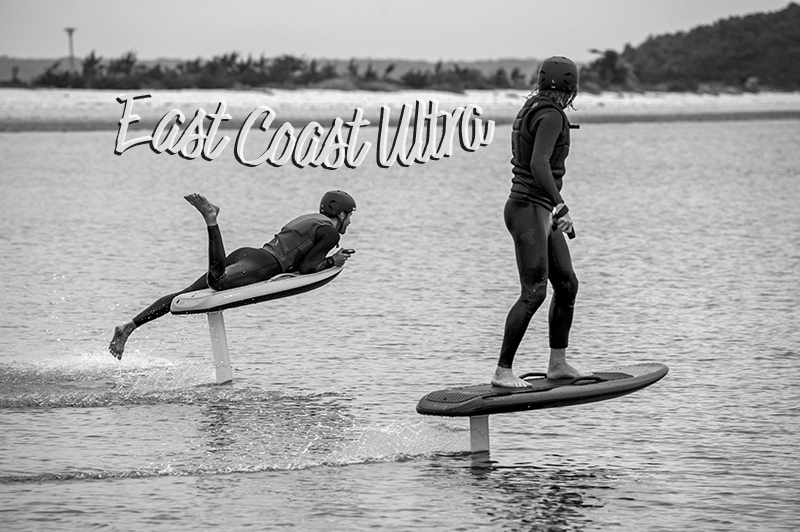




 Rain patters gently on the roof of the house. It’s a midsummer rainstorm forecasted to last only the next two days, but I’m already concerned our trip might get postponed. I call Rudi — he picks up on the first ring — and excuse myself as it’s quite early. Fresh off the boat from California, I’m not familiar with the local weather patterns yet. The consensus is that the system should pass just in time for us to be good this weekend. It wouldn’t be the first time a foiling trip of mine was delayed by poor weather, but I still cross my fingers as if it’ll help.
Rain patters gently on the roof of the house. It’s a midsummer rainstorm forecasted to last only the next two days, but I’m already concerned our trip might get postponed. I call Rudi — he picks up on the first ring — and excuse myself as it’s quite early. Fresh off the boat from California, I’m not familiar with the local weather patterns yet. The consensus is that the system should pass just in time for us to be good this weekend. It wouldn’t be the first time a foiling trip of mine was delayed by poor weather, but I still cross my fingers as if it’ll help.



 Released in tandem with the Ultra, there are a dozen new wings in the Fliteboard lineup this year. Rudi clues me in on the new Flow, Flow S, and Race wings. Seeing is believing, and in person I can now appreciate the subtle (and not so subtle) details in the shape of these wings; it’s clear they’re designed by a pair of Webb Institute-educated naval architects whose hobbies include going at mind-bending speeds on kite racing foils. With a quiver of the highest-performance foils at home, I can admittedly be a bit of a foil snob. These wings though, I can’t wait to ride. As for the controller, there are also updates to the previous generation. While I know there’s more in the pipeline from Fliteboard on this front, Rudi tells me experienced users are enjoying the subtle changes for the new generation. The entire system links up to the Fliteboard app, giving users all sorts of data about their board, riding, and software info.
Released in tandem with the Ultra, there are a dozen new wings in the Fliteboard lineup this year. Rudi clues me in on the new Flow, Flow S, and Race wings. Seeing is believing, and in person I can now appreciate the subtle (and not so subtle) details in the shape of these wings; it’s clear they’re designed by a pair of Webb Institute-educated naval architects whose hobbies include going at mind-bending speeds on kite racing foils. With a quiver of the highest-performance foils at home, I can admittedly be a bit of a foil snob. These wings though, I can’t wait to ride. As for the controller, there are also updates to the previous generation. While I know there’s more in the pipeline from Fliteboard on this front, Rudi tells me experienced users are enjoying the subtle changes for the new generation. The entire system links up to the Fliteboard app, giving users all sorts of data about their board, riding, and software info.
